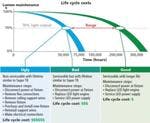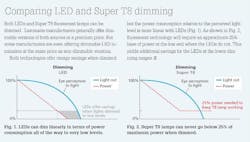Super T8s
Super T8 is a generic term used to describe the latest T8 lamps with higher light output of 3100+ initial lumens. Super T8 Lamps are offered by a number of major lamp manufacturers and also feature high lumen maintenance, high CRI, and long life. These lamps operate the same from an electrical standpoint as existing 32W T8 lamps and can be used with existing fluorescent ballasts.
While T5 and T5HO lamps are favored by designers for certain applications, the T8 lamp is the volume leader and it is the lamp that has seen the most recent advancements. Accordingly, we will focus on how well LEDs compete against a new generation of Super T8 lamps that are cheap, widely available in many different color temperatures, last a long time, and are easy to control.
Ballast technology has also improved and high-efficiency options deliver improved energy savings over older technology. Electronic fluorescent ballasts have been redesigned to last longer and dimming ballasts for fluorescent lamps have become less expensive. There are also a variety of ballast factors available for Super T8 lamps which provide designers with the ability to tune the light level and corresponding energy consumption.
Author disclaimer
Finelite does not manufacture Super T8 lamps. Finelite does not manufacture LEDs. For over 21 years, Finelite has designed and manufactured high-performance luminaires that use T8 lamps. For over 6 years, Finelite has designed and manufactured luminaires that use LEDs. We have purchased LEDs from three of the leading manufacturers and have reliability data for millions of LEDs and their power supplies. For nearly two years Finelite has participated with the DOE-sponsored committee that addresses LED luminaire reliability and lifetime. Accordingly, Finelite is often asked which light source, LEDs or Super T8s, is best. Read along to see how we respond to some frequently asked questions.
Are LEDs more energy efficient than 4-foot long Super T8 lamps?
What we need to look at is the efficiency of LED-based luminaires versus Super T8-based luminaires. This system look is required because an individual LED or T8 lamp does not perform useful work until it is connected to a power supply and installed in a luminaire that has the appropriate light distribution. Table 1 describes where the technology stood as of Q2 2012.
Getting to the bottom line in terms of system efficacy, the best LED-based recessed luminaires (90 to 110 lm/W for 2×2 and 2×4 luminaires) now outperform the best Super T8-based luminaires (80 to 85 lm/W). However, other LED-based recessed luminaires fall short of the best performing Super T8 luminaire.
Now you have probably read about LEDs that produce over 200 lm/W. So you may ask, “Why did you use such low values in your comparison?” The reports are for LEDs that are pulsed for just a few milliseconds and do not reflect steady-state operation. These LEDs are too blue-white for general-purpose usage. They are generally laboratory samples and are not ready for volume production. And remember, these reported efficacies do not include LED power supply or luminaire losses.
Will LEDs last longer than Super T8 lamps?
Longevity is a complex issue. Readers that want to look into lifetime deeply should go to the US Department of Energy (DOE) solid-state lighting (SSL) website and download the paper: “LED Luminaire Testing, Reliability, and Lifetime Report” (http://bit.ly/c3Bi2m).
Let’s discuss some of the report’s key points. Super T8 lamps “turn off” at the end of their life. Most people are aware of how Super T8 lamps operate. They deliver approximately 90% light output until they shut off, which is typically from 50,000 to nearly 80,000 hours.
LEDs do not “turn off.” LEDs get dimmer and dimmer over time until the light fades to nothing. Generally, the useful light of a single LED is expected to be the hours it takes for the lumen output to fall 30% below its initial output. That is called the LED’s L70 hours of operation.
Lifetime for the LED-luminaire is more complex and different than the lifetime for the LED. LED-luminaire lifetime needs to combine the probability that a component will fail (like the power supply or optical system) together with the probability that the LED-light-engine output falls below an acceptable level.
Will LEDs have lower life-cycle costs that Super T8s?
The cost to replace a Super T8 lamp and ballast is well-known and straight forward. You can expect maintenance costs to run about $1.00 per 1,000 hours of operation.
The cost to restore a LED-based luminaire to its initial light level breaks into three categories: the good, the bad, and the ugly (Fig. 1). The good are easy-to-service LED-luminaires that run cool and deliver L70 light output over 100,000 hours. These will nearly always deliver savings over Super T8-based luminaires.
The bad are serviceable LED-based luminaires that estimate L70 lifetimes shorter than 50,000 hours. Since the cost of an LED-light engine will nearly always be greater than a Super T8 lamp, it will be hard to ensure lower life-cycle costs for these luminaires.
The ugly are non-serviceable LED-based luminaires that need to be removed at their end of life. These will never be able to offer lower life-cycle costs than using Super T8-based luminaires, or good LED-based luminaires.
Are LEDs better suited to control strategies than Super T8s?
Since the future of lighting is going to be closely tied to sensors and controls, it is important to get to the bottom of this question. The key variables are summarized in Table 2. Both technologies support dimming, although LEDs have a clear advantage at lower dimming levels because Super T8s must consume a minimum of 25% of maximum power to continue to operate. See sidebar “Comparing LED and Super T8 dimming” for more details.
Some people claim that because LEDs are electronic devices, sensors and controls will eventually be designed right into the LED chip. That may be true. However, if these devices exist, they are still in the early R&D stage. Their commercialization will be so far in the future that decisions made today should not reflect whether they become commercially viable or not.
What else should I be looking at when I compare LEDs versus Super T8s?
First and foremost, verify that your lighting design uses best practices before you dive into which light source is better. For example, independent studies recommend using a “task – ambient” approach to lighting the office. Using that approach will help ensure well-lighted vertical surfaces that ensure the space feels comfortable and safe.
Task lighting will give individual control to the people in the space and provide light levels for a workforce that spans ages from the early 20s to the 70s. Meanwhile the combination of task and ambient light can deliver a general layer of light that has less than 0.5 watts per square foot lighting power density.
Proper use of vacancy sensors and other controls will reduce the actual connected load even more. Accordingly, use layouts that optimize LED luminaire placement to achieve 0.5 watts per square foot and compare them to layouts that use Super T8 lamps to deliver similar performance. That will give you factual data to compare claims of energy savings, cost savings, life-cycle savings and control savings for LEDs versus Super T8s.
Executive Summary
Luminaire selection and the lighting application impacts energy efficiency more than whether you use LEDs or Super T8s. LED-luminaire design will determine whether LEDs deliver on the promise of long life or whether they burn bright and die young. Avoid using non-serviceable LED-based luminaires for general-purpose lighting. Otherwise, you will experience dramatically higher life-cycle costs than with other solutions.
Cost-effective control strategies can be successfully implemented with either LED- or Super-T8-based systems. If your lighting design uses more than 0.5 watts per square foot, be sure to look at best practice lighting designs. Best practices will allow you to avoid buying and installing too many luminaires for the application; to achieve energy savings by matching the proper luminaire with the right light engine; to realize lower lifecycle costs due to easy-to-service and long-life luminaires; and to deliver a successful project with the right light engine at the right price for your job.









